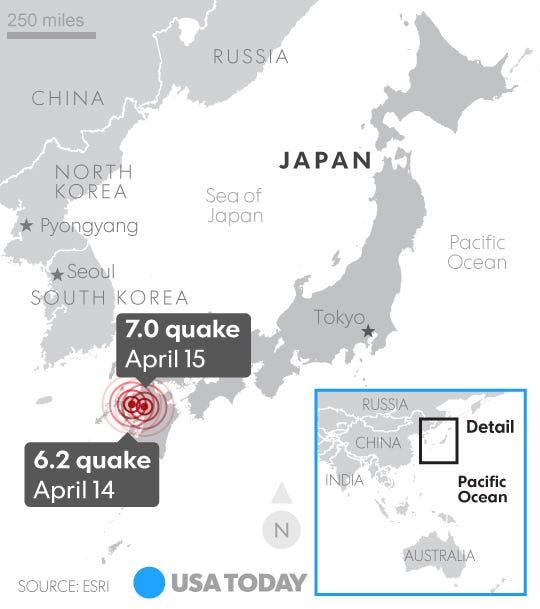What it will be like if you experience an earthquake?
( Kyushu) - A tsunami warning was lifted and no irregularities were reported at three nuclear plants early Saturday after a strong aftershock from a Thursday earthquake hit southern Japan, local media said.
The new quake, measuring 7.1 magnitude according to the Japan Meteorological Agency, caused some injuries and trapped some people in the area around Kumamoto on the southernmost main island of Kyushu, public broadcaster NHK said.
A tsunami warning after the 1:25 a.m. (1025 ET) quake was lifted, media said. There were no irregularities at Kyushu's Sendai nuclear plant, which continued to operated, or at the Genkai plant, also on Kyushu, or the Ikata plant on nearby Shikoku, NHK said.

A new aftershock measuring 5.4 hit southern Japan early Saturday, following a 7.0-magnitude quake that killed at least six people overnight.
Kumamoto Prefectural official Tomoyuki Tanaka told The Associated Press that the death toll in the latest temblor was still unclear.
More than 400 people were reported injured.
A magnitude-6.5 quake struck late Thursday, killing 10 people. Aftershocks have been rattling various areas in Kyushu, one of Japan's main four islands.
Hundreds of patients were evacuated early Saturday from a hospital near collapse after a powerful magnitude-7.0 earthquake — the second major temblor in barely 24 hours — struck the southwest Japanese island of Kyushu, according to the U.S. Geological Survey.
Police said at least one person was confirmed dead in that quake.
The 500-bed city hospital in Kumamoto was one of several buildings nearly demolished by the quake, according to the Japanese broadcaster NHK.
First responders were also receiving calls from residents reporting people trapped inside houses and buildings, NHK reports. Video showed a resident, apparently rescued from underneath a collapsed house, on a stretcher being taken to a hospital by ambulance.
Tens of thousands of people reportedly fled their homes as the quake rocked the area around 1:25 a.m. local time early Saturday. In Uto, about 17 miles south of Kumamoto, the city hall partially collapsed, Kyodo News reports.
The earthquake was centered a half mile from Kumamoto, the capital city of the Kumamoto prefecture, according to the U.S. Geological Survey. The region is located on the southwestern-most main island of Kyushu, where 13 million people live.
Mashiki, a suburb of Kumamoto, was the worst-hit town in Thursday's quake, a magnitude-6.2. Prime Minister Shinzo Abe had planned to travel to the area Saturday, but canceled the trip following the second temblor, Kyodo News reports.
Saturday's quake was about 6.3 times bigger on a seismogram and 15.8 times stronger in its energy release than Thursday's temblor, according to the USGS.
About 5-10% of earthquakes are followed by a bigger one within a few days, said John Vidale, a seismologist at the University of Washington in Seattle. But magnitude-6 and larger quakes, especially so close to major cities, aren't common, he added.
"This one-two punch with a serious impact is fortunately quite rare," Vidale said.
Saturday’s quake occurred where two tectonic plates converge. The Philippine Sea plate is sliding under the Eurasia plate at a speed of about 2 inches a year, according to USGS.
Early Friday, rescuers pulled an eight-month-old baby girl from rubble in Mashiki after the magnitude-6.2 quake struck the area at 9:26 p.m. the previous night.
The Japan Meteorological Agency said over 140 aftershocks were recorded by Friday evening and warned more strong tremors might occur in the coming days, Kyodo news agency reported.
More than 44,000 people sought shelter in schools and community centers after the quake hit Thursday, with some spending the night outdoors, Reuters reported.
Buildings were damaged, highways crumbled and a bullet train was derailed by the quake, Japanese broadcaster NHK reported. It said no passengers were aboard the train and there were no injuries.
None of the nuclear power plants in the affected area reported damage, according to a statement released by Prime Minister Shinzo Abe’s office.
In 2011, an earthquake and tsunami struck northeastern Japan, killing more than 16,000 people. About 2,500 remain missing.
Contributing: Kirk Spitzer, Doyle Rice, USA TODAY

No comments:
Post a Comment